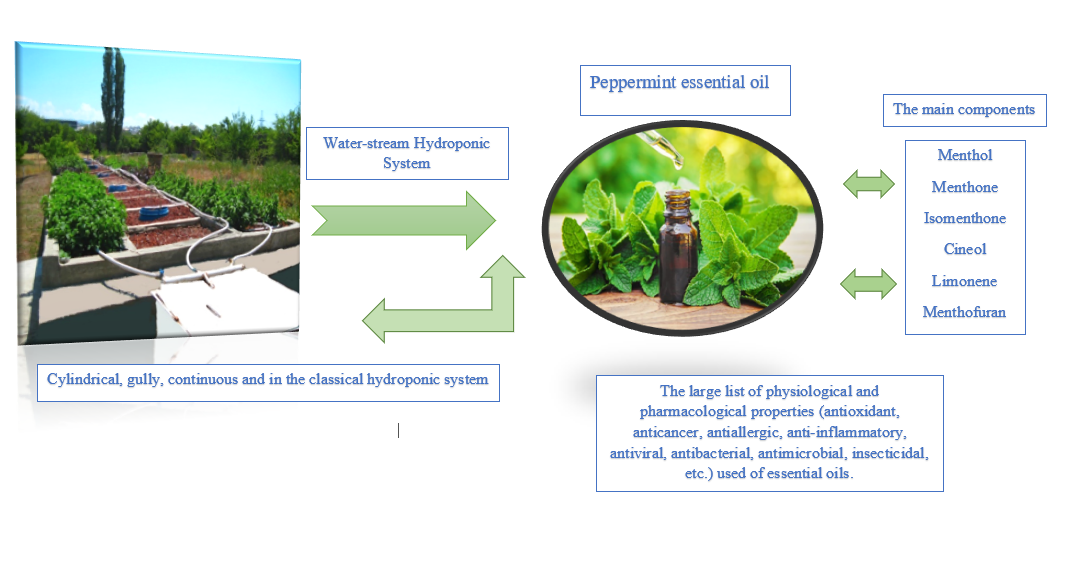Estimating peppermint essential oil levels: water-stream and classical hydroponic systems
DOI:
https://doi.org/10.31989/ffhd.v13i7.1123Abstract
Background: The leaves of peppermint and the essential oil received from them are used in medicine. The chemical content of essential oil is quite complex. It contains about 30 terpene compounds. The content of essential oil in flowers is 4-6%; in leaves – 2.4-2.8%, and in stems 0.3%. The main components that define the quality of essential oils are menthol, menthone, limonene, menthofuran, and isomenthone. Peppermint is used in the form of tea, tincture, extract, and salves. It has a regulating influence on the heart and circulatory system. It calms the heartbeat and supports the decrease of blood pressure, and the oil stream is used for dyspnea in the form of inhalation. Plant cream is used against insect bites, eczema, hemorrhoids, muscle pains, and some chronic diseases.
Context and purpose of this study: The work aimed to study the content of the main components from the quality indicators of the essential oil of peppermint grown in different water-stream and classical hydroponic systems for the first time in Armenia.
Results: From the analyses, it was revealed that the strengthening of the essential oil of peppermint grown in different systems of the water-stream hydroponics (cylindrical, gully, continuous) and classical hydroponics was observed in August. At the same time, high-yield plants of cylindrical and classical hydroponic systems exceeded other variants by 1.3-1.5 times with the essential oil output. In hydroponic systems, the specificities of the physical-chemical indices of peppermint essential oil were also studied. In August, the refractive indicator of essential oil increased to some extent in all variants, except for continuous hydroponics. The lack of increase in continuous hydroponics can likely be explained by the change in the ratio of essential oil to different compounds. At the end of vegetation, in September, some increase of essential oils' specific gravity was observed in the gully (2.1-3.5%) and continuous (4.5-4.7%) modules, while in cylindrical and classical hydroponics the change was minor. During vegetation, the essential oil of plant leaves was subject to not only quantitative but also qualitative changes. The cylindrical system exceeded other water-stream hydroponics variants with the main essential oil menthol component by 1.1-1.4 times and classical hydroponics by 1.1 times. The Gully system exceeded other water-stream systems with the content of D-Limonene and Menthyl acetate 3.6-9.7 and 1.3-3.0 times, respectively. And classical hydroponics 1.4 and 1.7 times, respectively. In the continuous system, the content of Isomentone, Pulegone, and Mint furanone was 1.3-2.0, 3.3-3.5, and 5.7-6.2 times higher, respectively, compared with the other water-stream hydroponic systems, and 1.6, 2.6, and 1.7 times, compared with classical hydroponics. Classical hydroponics exceeded all variants of water-stream hydroponics in the content of Piperidone by 3.3-4.1 times.
Conclusion:Although the strengthening of essential oil biosynthesis was observed in all hydroponic variants in August, the cylindrical hydroponic system excelled in the content of essential oils, the most important qualitative indicator of menthol. High output of essential oil in plant raw material was observed in classical hydroponics and cylindrical system of water-stream hydroponics, which provides optimal regimen for the normal growth and development of plants.

Keywords: cylindrical, medicinal plant, bioactive compounds, menthol


Downloads
Published
Issue
Section
License
Any manuscripts or substantial parts of it, submitted to the journal must not be under consideration by or previously published in any other journal or citable form. Authors are required to ensure that no material submitted as part of a manuscript infringes existing copyrights or the rights of a third party. In submitting one's article in any form, the author has assigned the FFC publishing rights and has agreed to an automatic transfer of the copyright to the publisher. This is so that the FFC may create print option journals, for example, at the FFC’s discretion. If the author wishes to distribute their works by means outside of the FFC, for example within their community, they will have to place a request.
Correspondence concerning articles published in Functional Foods in Health and Disease is encouraged. While derivative works (adaptations, extensions on the current work, etc.) are allowed, distribution of the modified material is not allowed without permission from the FFC.